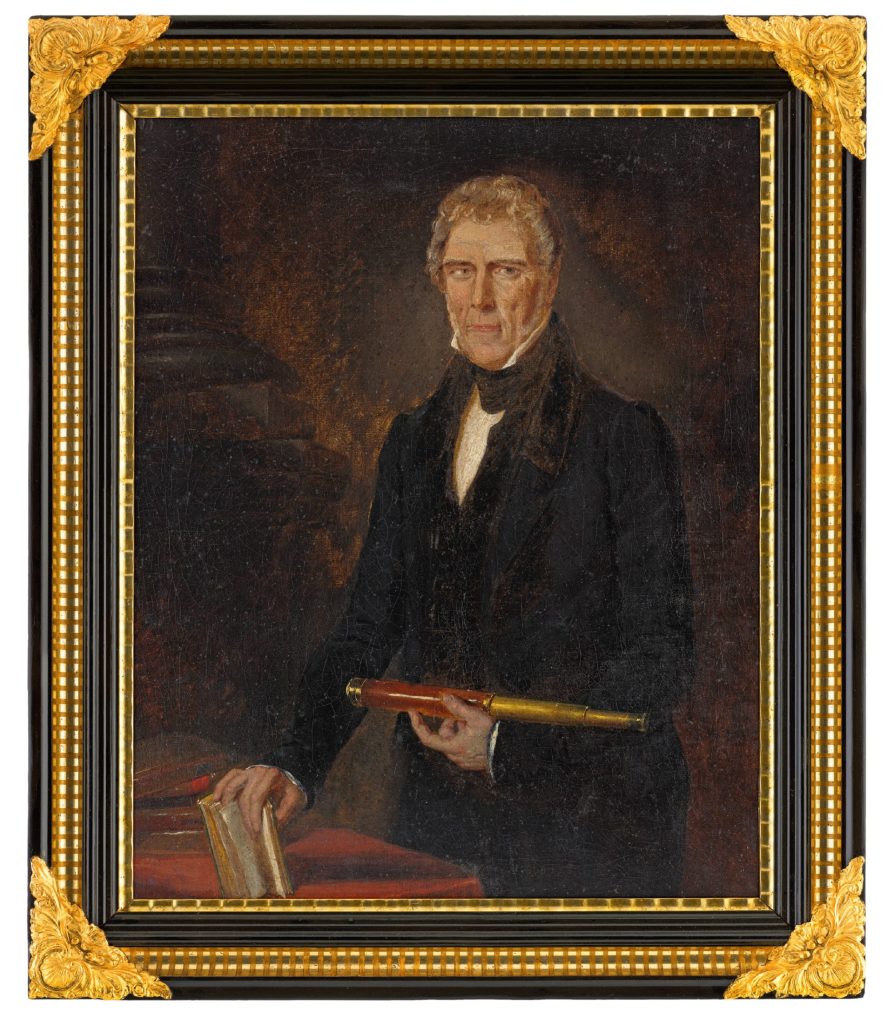If you visit the State Library of New South Wales you will discover an unrivalled collection of oil paintings. It features works from artists such as Conrad Martens and John Glover, and others of variable quality, execution and skill, with a range of formats and diversity of subjects that tell us much about Australia.
RACHEL FRANKS and RICHARD NEVILLE have published Reading the Rooms which reveals this little-known collection. It delivers a fascinating and authoritative account of hundreds of paintings, and a compelling argument for their importance.
We find out about a painting of Solomon Wiseman, the great-great-great grandfather of one of Australia’s most popular authors.
‘UP TO ITS BLIND EYE’

Solomon Wiseman, ca. 1820–38
Solomon Wiseman, ca. 1820–38
artist unknown
ML 1086, acquired 1994
For Janet Litchfield, the portrait of her great-great- grandfather Solomon Wiseman (1777–1838) was inseparable from a tragedy inher immediate family. This painting of her convict-turned-businessman forebear had been passed down through the male line. When itcame to her generation, though, there was no male heir. ‘My only brother, Richard Cameron Denbow Wiseman, was killed playing football for Sydney Grammar against St Josephs in 1927 when he was 17’, she told the Library when she donated the portrait in the 1990s, ‘so I am handing on the painting to the Mitchell Library’.
The oil portrait in an ebony frame with decorative gold corners shows an affluent man of the New South Wales colony in the early 1800s. In the style of British portraits of the period, it presents him against a dark background dominated by a classical column. He holds objects that signify his wealth andlearning: a book with fine binding and a polished telescope. It is hard to believe this is the same man who was given a death sentence in 1805 for stealing a significant quantity of wood as a boatman on London’s River Thames, then commuted to transportation for life.
Although the names of the sitter and the artist do not appear on the portrait, the Library was able to confirm that Wiseman is its subject. Along with its persuasive family provenance, the painting resembles another portrait of Wiseman (which has disappeared, but is recorded in a photograph held by New South Wales State Archives).
In that portrait, Wiseman’s name is visible on a letter addressed to him in the foreground. The telescope shown in both paintings has reportedly remained in family hands.
A contemporary of Wiseman’s, Judge Roger Therry, recalled that Wiseman was ‘never without a telescope in hand’ as he looked out forvisitors to the area where the Hawkesbury and Macdonald rivers meet, that would later be named Wisemans Ferry. He found Wiseman to bea shrewd and prosperous landowner, whose latest enterprise was supplying the government with provisions for road-building convicts. But Therry was appalled by Wiseman’s lack of interest in education. ‘In literary attainments of any kind old Solomon was sadly deficient’, Therry wrote in his 1863 Reminiscences, ‘and took unmerciful liberties with the English language and English history’.
In 2005, 10 years after Mrs Litchfield’s donation of the portrait, another Solomon Wiseman descendant turned his story into a literary achievement. The writer Kate Grenville had known since childhood that her great-great-great grandfather had been a convict, but knew nothing about his life. She set out to write a non-fiction book about him, which eventually became the novel The Secret River (2005). The character William Thornhill is based on Wiseman.
In her quest to understand her ancestor’s relationship with the Darug people, whose land he had taken, Grenville reflected in her 2006 book, Searching for the Secret River, that her ‘family story had been holding the telescope up to its blind eye’.
Cathy Perkins
ABOUT THE EDITORS
RICHARD NEVILLE, a graduate of the University of Sydney, is the Mitchell Librarian and Director, Engagement at the State Library of New South Wales. With a research background in 19th-century Australian art and culture, he has curated numerous exhibitions and published widely on colonial art and society. He has also been extensively involved in the acquisition, arrangement, description and promotion of the Library’s renowned Australian research collections. He is the author of Mr JW Lewin: Painter and Naturalist (2012).
RACHEL FRANKS is the coordinator of scholarship at the State Library of New South Wales. She holds PhDs in Australian crime fiction (Central Queensland University) and in true crime texts (University of Sydney). A qualified educator and librarian, her extensive work on crime fiction, true crime, popular culture and information science has been presented at numerous conferences, as well as on radio and television. An award-winning writer, her research can be found in a wide variety of books, journals, magazines and online resources. She is the author of An Uncommon Hangman: The Life and Deaths of Robert ‘Nosey Bob’ Howard (2022).







For such an important book the binding on the copy available from the bookshops is very much below par, The standard of writing, design and reproduction is completely let down by the binding. Lets hope that the Library produce a much better edition, possible signed by Vallance, Neville and Franks